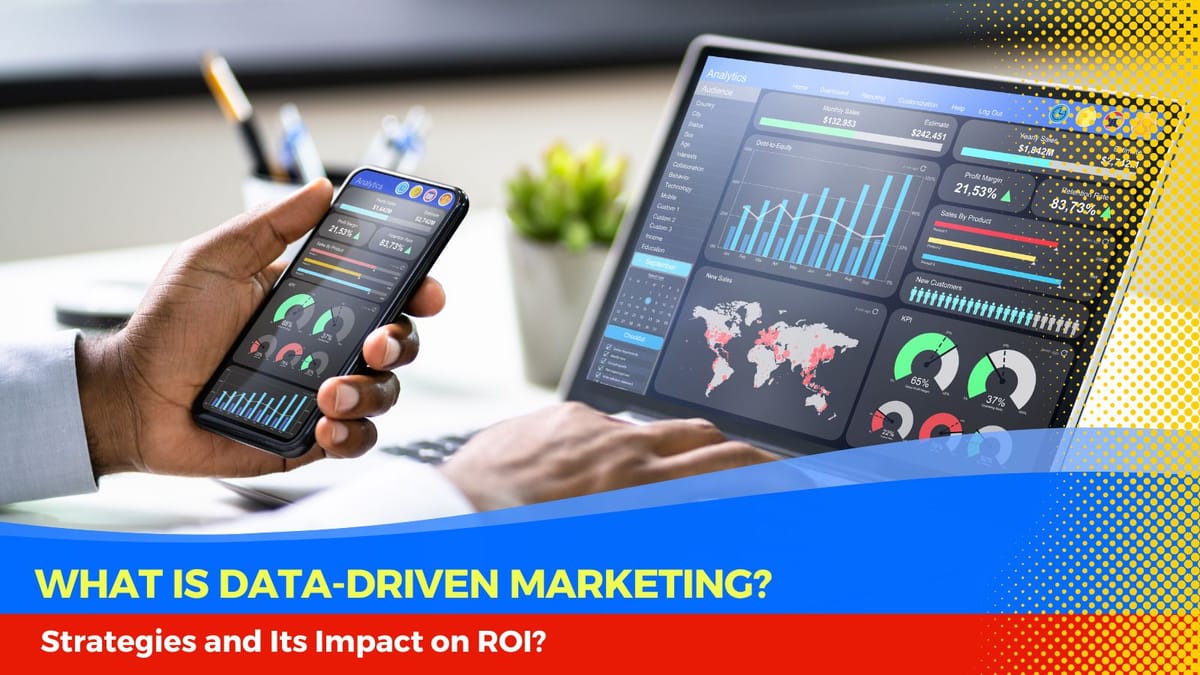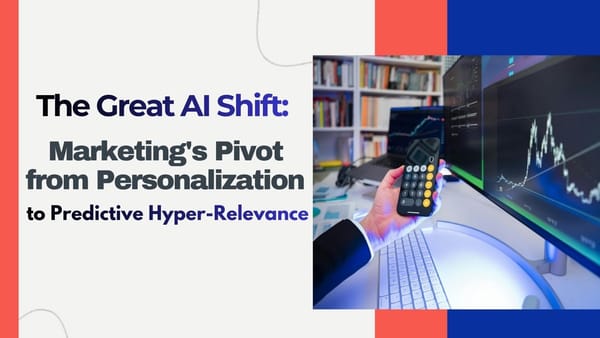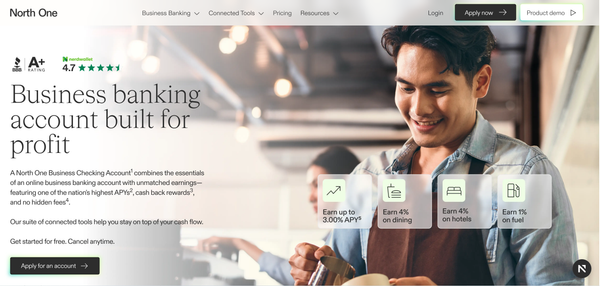What is Data-Driven Marketing, Strategies and Its Impact on ROI?

Wondering how data-driven marketing is influencing today's business landscape? This comprehensive article delves into the essence of data-driven marketing, effective strategies underpinning it, and how these can significantly impact your return on investment (ROI). Explore the transformative power of data in marketing and prepare to leverage insights for substantial business growth.
1. What is Data-Driven Marketing?
1.1 Definition and Basics
Data-Driven Marketing refers to strategies and efforts that leverage data analysis to inform marketing decisions. It's not just about amassing huge volumes of data; it's how you use that data to better understand your customers, predict trends, and craft targeted marketing campaigns. In practice, this means gathering data from various sources – customer interactions, social media, email engagements, and more – then analysing this data to identify opportunities, personalise messages, and predict future customer behaviours.
Key components include:
- Customer data analysis
- Predictive modeling
- Personalised marketing tactics
- Performance tracking and analysis
Pro-tip: Start by consolidating your data sources to ensure a unified view of your customer interactions. This consolidation will be your foundation for nuanced insights and targeted marketing strategies.
1.2 Importance in Today’s Digital Age
In a world where consumers are bombarded with countless marketing messages daily, standing out requires a tailored and relevant approach. Data-driven marketing facilitates this by allowing businesses to send the right message, to the right person, at the right time. Not only does this approach increase engagement and conversions, but it also enhances customer satisfaction by providing value instead of just noise.
According to a recent study by the Data & Marketing Association, businesses that implement data-driven marketing strategies are more likely to have an advantage over the competition and achieve profitability. Thus, in the digital age where personalisation and efficiency are key, adopting a data-driven approach is no longer optional but critical for business success.
Pro-tip: Leverage AI and machine learning technologies to parse through data more efficiently, identifying patterns and insights that can lead to more strategic marketing decisions.
1.3 How Data-Driven Marketing Improves Decision-Making
The beauty of data-driven marketing lies in its capacity to transform intuition-based decisions into informed choices. With access to real-time data, marketers can quickly adjust campaigns for better performance, allocate budgets more effectively, and identify underperforming channels. This agility is invaluable in today’s fast-paced market, where consumer preferences are constantly evolving.
Furthermore, by continually monitoring and analysing data, businesses can foster a culture of continuous improvement. This means not just reacting to the market trends but also anticipating changes and staying a step ahead. Consequently, data-driven marketing not only refines your current strategies but also ensures that future decisions are grounded in solid, empirical evidence.
3 Key benefits include:
- Enhanced agility and flexibility in marketing decisions
- Improved budget allocation based on performance data
- Foresight into market trends and consumer behaviour
Pro-tip: Establish a robust analytics platform to enable seamless data analysis and insight generation, ensuring that your marketing strategies are always informed by the latest data.
2. Key Strategies in Data-Driven Marketing
2.1 Personalisation and Targeted Campaigns
Gone are the days of one-size-fits-all marketing. Today, personalisation is the cornerstone of effective marketing strategies, and it's all thanks to data. Personalisation means tailoring your marketing messages and offers to meet the unique needs and preferences of your target audience. With comprehensive customer data, businesses can create highly targeted campaigns that speak directly to the individual interests of their customers. This approach not only enhances customer experience but significantly boosts conversion rates and loyalty.
Actionable Insight: Start by segmenting your customer data based on demographics, buying behaviour, and engagement levels. Use this segmented data to craft personalised email campaigns, content, and offers that resonate with each group. Remember, the goal is to make every customer feel recognised and valued. Recent studies, including one by Epsilon, found that 80% of consumers are more likely to make a purchase when brands offer personalised experiences. By leveraging the power of personalisation, you tap into a proven method for enhancing your marketing effectiveness.
2.2 Use of Analytics and AI for Customer Insights
Analytics and Artificial Intelligence (AI) have transformed the landscape of marketing by enabling deeper insights into customer behaviour and preferences. Through the use of sophisticated analytics tools, marketers can now predict customer trends, identify opportunities for engagement, and optimise their strategies in real-time. AI goes a step further by not just analysing data but learning from it, allowing for more precise targeting and personalisation.
Pro-tip: Implement AI-driven analytics tools to mine and analyse your data. Look for patterns in purchase history, website navigation, and social media engagement to anticipate customer needs and interests. Then, adjust your marketing strategies accordingly to stay ahead of trends. Furthermore, AI can help automate routine tasks, freeing up your team to focus on creative and strategic initiatives. This dual approach maximises the efficiency and effectiveness of your marketing efforts, ensuring you get the best return on your investment.
2.3 Integrating Data-Driven Approaches with Bloomclicks Digital Advertising
Integrating data-driven approaches into your marketing strategy amplifies its impact, and platforms like Bloomclicks pave the way for achieving this seamlessly. This integration allows for the application of detailed analytics and customer insights directly into advertising campaigns, making them more targeted and effective. The use of Bloomclicks' platform facilitates customised dashboards and robust reporting, providing real-time insights into trends and ROI. This level of detail enables businesses to quickly adapt their strategies based on performance metrics.
How to Benefit: Use Bloomclicks Digital Advertising to dive deep into your campaign analytics. This not only helps in tracking the performance of your ads but also in understanding how your target audience interacts with your content. By analysing these interactions, you can fine-tune your campaigns for optimal performance. Additionally, Bloomclicks' vast network of over 4000 global affiliate partners can dramatically expand your reach, connecting you with audiences you might not have been able to engage otherwise. The key to maximising your ROI lies in how well you can integrate these insights and resources into your overall marketing strategy.
3. Measuring the Impact of Data-Driven Marketing on ROI
3.1 Understanding ROI in Marketing
Understanding the return on investment (ROI) in marketing is crucial for businesses aiming to evaluate the efficiency and profitability of their promotional activities. Essentially, ROI measures the gain or loss generated by your marketing efforts, compared to the amount of money invested. To calculate ROI in a straightforward manner, you subtract the marketing cost from the sales growth and then divide this by the marketing cost again. This will give you a percentage that signifies your marketing campaign's profitability.
A key to enhancing ROI is through targeted campaign strategies and efficient budget allocation. By leveraging data-driven insights, companies can identify which marketing channels deliver the best results and allocate their budgets more effectively. Remember, a positive ROI indicates that your marketing strategies are working well, but there's always room for improvement. It's a continuous cycle of analysing data, implementing changes, and measuring outcomes.
3.2 Key Performance Indicators (KPIs) to Monitor
Monitoring the right Key Performance Indicators (KPIs) is vital in understanding how effectively your data-driven marketing strategies are boosting your ROI. Here are some critical KPIs you should keep an eye on:
- Conversion Rate: Reflects the percentage of users who take a desired action like making a purchase. This KPI directly impacts ROI and helps gauge the effectiveness of your campaign messaging and targeting.
- Cost per Acquisition (CPA): Indicates the cost of acquiring a new customer through a particular campaign or channel. Lowering your CPA can significantly enhance your ROI.
- Customer Lifetime Value (CLV): Measures the total revenue a business can expect from a single customer account. It helps in determining how much to invest in retaining existing customers versus acquiring new ones.
Pro-tip: Utilising tools like Bloomclicks Digital Advertising can help in accurately measuring these KPIs, enabling your business to make data-driven decisions swiftly. According to a recent study by Forbes, companies that adopt data-driven marketing are more likely to have an advantage in decision-making and achieve significant improvements in their ROI.
3.3 Case Studies: Real-World Success Stories
Real-world success stories provide tangible proof of how data-driven marketing can significantly impact ROI. For instance, a leading E-commerce platform leveraged personalised email marketing campaigns based on user behaviour data. By segmenting their audience and tailoring their messages to fit individual customer preferences, they saw a 25% increase in conversion rates and a substantial boost in their ROI.
Another success story comes from a SaaS company that utilised advanced analytics to optimise their ad spend across various channels. By focusing on high-performing channels and discontinuing underperforming ads, they were able to reduce their CPA by 30% while simultaneously increasing their subscriber base.
Pro-tip: Each of these case studies highlights the importance of continuously monitoring and analysing your marketing campaigns' performance. With platforms like Bloomclicks, automating this analysis and making informed adjustments becomes simpler, enabling a more efficient path to achieving higher ROI.
4. Overcoming Challenges in Data-Driven Marketing
4.1 Identifying and Collecting Quality Data
Data is the lifeblood of data-driven marketing, but not all data is created equal. Identifying and collecting quality data is essential to ensure your marketing strategies are built on a solid foundation. You must focus on gathering data that is accurate, relevant, and timely. This can involve utilising a mix of internal data sources, such as customer behaviour on your website, and external sources, such as market research. However, the challenge doesn't stop at collection; ensuring data quality and consistency is critical. This means regular data cleansing and validation to remove inaccuracies and duplications.
Pro-tip: To streamline data collection and improve quality, consider automating data aggregation from various sources. Tools that collate data from social media interactions, website analytics, and customer purchases can provide a comprehensive view of your audience, making it easier to tailor your marketing efforts effectively.
4.2 Ensuring Privacy and Data Protection
In today's digital landscape, privacy and data protection are not just legal requirements; they're crucial for building trust with your customers. The General Data Protection Regulation (GDPR) in Europe, and similar regulations in other regions, have heightened the need for businesses to manage customer data responsibly. This involves getting explicit consent for data collection, enabling customers to access or delete their data upon request, and ensuring that the data is securely stored and processed. Missteps in privacy and data protection can not only result in hefty fines but can also damage your brand's reputation.
Pro-tip: Implement privacy-by-design principles in your data-driven marketing strategies. This means considering data protection at every stage of your marketing campaign development. Ensure your team is trained on the latest data protection regulations and that your data practices are transparent. Regular audits can help you stay compliant and safeguard your customers' data.
4.3 Scalability and Continuous Improvement
Scaling your data-driven marketing efforts as your business grows is crucial for maintaining momentum and capitalising on new opportunities. However, scalability can be challenging. It requires systems that can handle increasing volumes of data, more complex data analysis, and a growing number of marketing campaigns without compromising performance. This often means investing in more advanced technology solutions or data management platforms that can grow with your business.
On the other hand, continuous improvement in data-driven marketing is about never being complacent. It involves consistently testing, learning from your data, and adapting your strategies based on what works and what doesn't. This requires a culture of experimentation and a willingness to fail and learn from those failures.
Pro-tip: Keep your tools and platforms adaptable. Solutions like Bloomclicks offer scalable advertisement and marketing options that grow with your business, ensuring you're not limited by your technology. Moreover, fostering a culture of continuous learning and data literacy within your team will enable you to swiftly adapt to changes and optimise for success.
Remember, overcoming these challenges is not a one-time effort but a continuous process that requires diligence, adaptation, and a proactive mindset.
5. Future of Data-Driven Marketing and How to Stay Ahead
5.1 Emerging Trends and Technologies
The landscape of data-driven marketing is constantly evolving, presenting new opportunities for brands to connect with their audience more effectively. One emerging trend is the use of augmented reality (AR) and virtual reality (VR) in marketing campaigns, which can create immersive experiences to engage users on a deeper level. Similarly, blockchain technology is starting to play a role in improving transparency and trust in marketing operations, particularly within supply chains and in ensuring the authenticity of ad delivery.
Another significant trend is the rise of voice search and voice-activated devices. As more consumers use voice assistants for information and shopping, optimizing content for voice search will become a crucial part of marketing strategies. Furthermore, the application of machine learning and predictive analytics is improving the accuracy of customer insights, enabling marketers to anticipate customer needs and tailor offerings accordingly.
5.2 Role of Partnership & Affiliate Marketing with Bloomclicks
Partnership and affiliate marketing have emerged as powerful strategies for expanding reach and driving revenue growth. Bloomclicks, a leading digital advertising platform, facilitates these strategies by connecting advertisers, brands, agencies, affiliates, and influencers in mutually beneficial partnerships. Through Bloomclicks, companies can easily:
- Discover and recruit a diverse range of partners.
- Engage and build genuine brand trust.
- Obtain direct access to partners' contact information to form new relationships.
- Evaluate partners based on their industry experience and overall fit for the business.
The flexible payment and invoicing system offered by Bloomclicks ensures seamless transactions across borders, supporting companies in their global expansion efforts. Moreover, Bloomclicks provides detailed, data-driven analytics, enabling brands to measure the effectiveness of their partnership and affiliate marketing initiatives accurately.
5.3 Preparing for a Data-Driven Future in Marketing
To stay ahead in the rapidly changing world of data-driven marketing, brands and marketers must remain agile and continuously adapt to new trends and tools. Firstly, investing in upskilling and training for employees in data analysis and digital marketing tools can provide a competitive edge. Secondly, fostering a culture of innovation will help in embracing new technologies and methodologies with ease.
Collaboration with technological pioneers and industry leaders can offer insights into emerging trends and access to cutting-edge technologies. Additionally, focusing on creating a seamless omnichannel customer experience will ensure that data-driven strategies translate into positive customer interactions across all touchpoints. Finally, maintaining a strong ethical stance on data privacy and protection will build trust with consumers and ensure compliance with evolving regulations.
In conclusion, embracing the future of data-driven marketing involves staying abreast of emerging trends, leveraging powerful platforms like Bloomclicks for partnership and affiliate marketing, investing in technological capabilities, and prioritising customer trust. By doing so, businesses can enhance their marketing strategies, drive significant ROI, and gain a distinct advantage in the marketplace.
Interested in leveraging advanced partnership and affiliate marketing strategies for your brand? Check out how Bloomclicks can help you scale up your efforts and achieve substantial growth: Schedule a 15-minute meeting with Bloomclicks strategists.
Frequently Asked Questions
What are data-driven marketing strategies?
Data-driven marketing strategies involve the use of data, analytics, and technology to understand and anticipate customer needs, preferences, and behaviours to create personalised marketing messages. Key strategies include:
- Personalisation of content and offers.
- Targeted campaigns based on customer data.
- Utilisation of analytics and AI for insights.
- A/B testing for performance optimisation.
- Integration of omnichannel marketing efforts.
What is ROI driven marketing?
ROI-driven marketing focuses on allocating marketing efforts and resources towards activities that produce a measurable return on investment. It involves:
- Setting clear objectives aligned with business goals.
- Measuring and analysing key performance indicators (KPIs).
- Regularly refining strategies based on performance data.
- Prioritising marketing channels and tactics with the highest ROI.
What are the effects of data-driven marketing?
The effects of data-driven marketing include:
- Enhanced customer insights, leading to better targeting.
- Increased engagement through personalised communication.
- Improved customer loyalty and retention.
- Optimisation of marketing spend by focusing on high-performing channels.
- Higher conversion rates and overall revenue growth.
What is ROI in digital marketing strategies?
ROI in digital marketing strategies refers to the return on investment from digital marketing activities. It is calculated by comparing the revenue generated from digital marketing efforts to the cost of those efforts. The aim is to maximise ROI by:
- Focusing on high-performance marketing channels.
- Optimising budget allocation across digital campaigns.
- Employing data-driven decision-making to refine strategies.
- Measuring and analysing campaign performance regularly.





